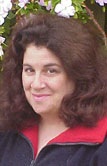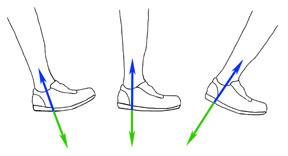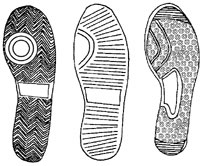January 2003 Article Tennis Server
|

 |
In last month's column we reviewed basic footwear components and the objectives of an athletic shoe. This month we'll discuss: tennis movements and the subsequent transfer of forces onto your foot and leg, shoe and surface interaction and the technology used to test shoe performance. Let's pick up where we left off. Last month's column concludes with the following comment, "However, here's the challenge. Aside from running, which primarily has one direction of motion (full steam straight ahead), most other sports have large variations in foot motions. [...] There are generic and sport specific injury patterns and it is no surprise to you that running injuries differ from court sports like tennis and basketball." Leg and Foot Motions In Tennis Unlike the consistent, repetitive motions in running, foot and leg movements in tennis vary greatly. Tennis leg and foot actions require:
Different movements create different forces on your lower extremities. In running, the direction of the forces placed on the foot and leg are primarily anterior (forward) and posterior (backwards) and vertical (up into the foot and leg). However, in tennis, forces also are encountered in the lateral and medial directions (the left and right directions). If you gently walk across a puddle of water you might tread through it without creating a lot of wave motion. Jump into the puddle and the water splashes all over. The forces you place on the water and the surface below it are much greater in the jump. Forces Encountered A force is a push or a pull; energy brought to bear which can cause a motion or a change. In footwear, forces are typically discussed in terms of bodyweight. The forces generated in the long jump in track can reach more than 5 times the body's weight. A 250-pound basketball player leaping from 3 feet platform can generate one ton (2000 pounds) of forces. The important point to note here is that your body encounters more than just its own weight worth of forces. Clearly the shoe and the surface is important in reducing the impact of those forces to your lower leg. Newton's 3rd Law of Motion states that for every action there is an equal and opposite reaction. When our bodies (shoes) make contact or impact the tennis court, we apply a force to that surface. Based on Newton's 3rd Law the shoe/court impact results in a reaction force of equal strength and opposite in direction to the force generated by your foot striking the court. In the diagram below, the foot landed flat on the court generating a force straight down (marked in green). The reaction force acts in the opposite direction and travels up into your body. Joints, muscles, tendons and bones encounter these forces.
Landing heel first results in a reaction force vertically (upwards) and backwards. Impact on the ball of the foot results in a reaction force upwards and forward. How do forces in tennis compare? Rapid stopping or foot planting creates some of the highest forces in tennis. Stopping in a running forehand has been shown to generate 4 times the bodyweight in forces. If the foot planting is heel first, that means the forces will act vertically and posteriorally. Side to side shuffling motion acts in the lateral direction. Biomechanically, our bodies are not designed to run as quickly with the shuffling motion. However, side shuffling in tennis will generate twice the body weight in forces. You can see that repeated forces or forces off-balance can cause injury. I'm sure that you've been able to surmise how improper landings, genetic or acquired patterns in your gait and motions with the incorrect footwear can cause an injury. (Next month we'll discuss injuries in more detail.) Shoe and Court Interaction The equal and opposite force does not necessarily travel back up your leg. The surface itself absorbs a portion of the force converting it to other forms of energy. Subsequently, tennis court surfaces are rated not only for pace but also for the percentage of force reduction. Laboratory tests have demonstrated force reductions compared to impact on concrete. Grass reduces the force by over 55 percent, clay and artificial turf about 25% and hard courts only about 5-10%. There is a correlation between pain, injury and surface hardness. With a wide variety of court surface types, shoe requirements change with the court type. The primary difference is essentially the patterns on the bottom of the outsole. Examine the soles of your athletic shoes and you will most likely note multiple distinct patterns on the outsoles. The patterns reflect the varying roles the parts of your foot play in performance. The foot does not apply pressure in a uniform manner and consequently, the sole of the athletic shoe reflects this in its design. There are a variety of traction patterns on the soles of athletic shoes. Traction (the amount of resistance to slip between the shoe's outsole and the contact surface) like any other shoe characteristic must be commensurate and balanced with the sport. As one shoe designer described it, "If increasing traction were the major consideration suction cups could easily be employed on a sole." Some of the most common patterns are: the herringbone, ribbed (radially) and pillar, nub or dimpled. Pictured below are examples of these patterns.
In tennis, traction assists in starting, stopping and sideward motions. However, too much traction on the sole not only interferes with foot lift-off, but could subsequently transmit large pressures to the ankle and knees when landing from a jump or planting the foot down and result in injuries. Flat sections (seen in b) or suction pivots (seen in a) on the sole are often placed on for pivoting and turning. In the past small metal spikes were used on the soles of grass court shoes. As grass court play became less common and multi-level traction patterns emerged spikes on tennis shoes have become uncommon. The herringbone pattern has been the standard for most court sports and grips well on the surface. Pillared surfaces have dual functions. As the foot lands the first layer of the pillar grips the surface. During foot planting and stopping sufficient pressure is placed on the first layer of pillars to compress them. Pressing in the pillar exposes the second pillar, which provides more traction. Now the shoe sole has a much larger traction area for stopping. Tools Of The Trade As athletic shoes have evolved so has the technology to determine shoe and shoe related athletic performance. There are three basic types of analysis. The shoe industry itself monitors the structural stresses on the shoes. Athletic footwear undergoes a variety of laboratory testing to measure characteristics such as seam strain, adhesion (testing the adhesive used especially for new materials), durability, heat absorption, water permeability, shock absorption and even cold-flexing of winter boots. Machines have been designed to simulate specific conditions like toe drag on a tennis shoe. Gait equipment is used to study the overall performance of the athlete in the shoe and the forces the lower extremities encounter. Shoe manufacturers and gait labs also use athlete testers. Machines have been designed to test structural and wear components of shoes. This provides a benchmark, a method to determine under identical conditions how one shoe compares to another. The tests are repeatable and data acquisition systems can accumulate performance information. There is no doubt in the industry that these tests have improved footwear performance. Do machine tests reflect the dynamic motion patterns and actual forces the foot and leg encounter in the shoe? Early lab tests used prosthetic feet and legs (artificial limbs) with flatfooted impact. Different shoes would be placed on the device and results compared between different shoes. Although this same action could be reproduced, a common criticism was that few athletic motions are "flat-footed." Regardless of a standard comparison the motion wasn't realistic. University gait laboratories began using force plates and acquisition systems that could monitor true athletic motion. Force plates are used to measure the pressures encountered by the foot. Systems such as Novel's Emed, Pedar and Pliance measure the pressure distribution on the foot. There is even a Pliance system embedded in a saddle to analyze the pressure distribution on a horse's back. Today the athletic footwear industry and researchers use all methods available: specialized laboratory machine, objective athletic tests, high-speed photography, film and video. Next month we'll conclude with some interesting information on cushioning, foot conditions and injuries, address specific questions readers submitted and note some athletic shoe websites. Happy New Year! Until next month ... Jani
References
Cheskin, M. Sherkin, K. and Bates, B., The Complete Handbook Of Athletic Footwear, Fairchild Publications, New York, 1987 Cooke, A. and Dixon, S., Sports Science and Engineering in Education: Sport Shoe Design, http://www.cookassociates.com, 2001-2002. Novel, http://www.novel.de, 2002. Segresser, B., Injuries And Sport Shoe Design: Wish And Reality, 2001 Footwear Symposium, Zurich, Switzerland, July 5-7, 2001. Thanks to Jim Pallis for the footwear graphics in this column. Sole patterns adapted from The Complete Handbook Of Athletic Footwear.
This column is copyrighted by Jani Macari Pallis, Ph.D., all rights
reserved.
Dr. Jani Macari Pallis is the founder and CEO of Cislunar Aerospace,
Inc., an engineering and research firm in San Francisco. In addition
to her engineering practice, she has led two collaborations between
NASA and Cislunar, creating educational materials on the aerodynamics
of sports for pre-college students and educators. As the head of
NASA's "Aerodynamics in Sports" project, she has led a team of
researchers investigating the aerodynamics, physics and biomechanics
of tennis. The group has conducted high speed video data capture at
the US Open and research of ball/court interaction, footwork, serve
speeds, trajectories and ball aerodynamics. Pallis received a BS and
MS from the Georgia Institute of Technology, an MS in mechanical
engineering from the University of California, Berkeley and a Ph.D.
in mechanical and aeronautical engineering from the University of
California, Davis. She is a member of the Executive Committee of The
International Sports Engineering Association.
Questions and comments about these columns can be directed to Jani by
using this form.
|



October 2022 Tennis Anyone: Patterns in Doubles by John Mills. September 2022 Tennis Anyone: Short Court by John Mills. |
 You will join 13,000 other subscribers in receiving news of updates to the Tennis Server along with monthly tennis tips from tennis pro Tom Veneziano.
You will join 13,000 other subscribers in receiving news of updates to the Tennis Server along with monthly tennis tips from tennis pro Tom Veneziano. 

